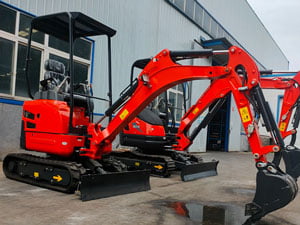Bienvenido a mi blog
Antes de sumergirnos en el contenido, me encantaría que te unieras a mí en mis plataformas de redes sociales, donde comparto más ideas, participo con la comunidad y publico actualizaciones. Así es como puedes conectar conmigo:
Facebook: https://www.facebook.com/profile.php?id=100072217509763
LinkedIn: https://www.linkedin.com/company/74949059/admin/dashboard/
YouTube:www.youtube.com/@tractormanufacturer-lc5qz,www.youtube.com/@fabricantes de excavadoras-sn9hk
TikTok: www.tiktok.com/@tractorfabricante, www.tiktok.com/@fabricantes de excavadoras
Empecemos nuestro viaje juntos. Espero que encuentres el contenido aquí perspicaz, atractivo y valioso.
Índice
Introducción

Excavadoras are essential pieces of equipment in the construction and mining industries, known for their versatility and strength. One of the most critical aspects of an excavator’s performance is its lifting capacity. The ability to lift heavy loads efficiently can significantly impact project timelines, safety, and overall productivity. In this article, we will explore four key ways that excavator lifting capacity boosts efficiency, enabling operators to maximize their effectiveness on job sites.
Enhanced Load Handling
Comprender Excavadora Lifting Capacity
The lifting capacity of an excavator is a critical parameter that indicates the maximum weight the machine can safely lift and transport during operations. This capacity is influenced by several factors, including the design of the machine, its weight distribution, and the efficiency of its hydraulic system. Each of these elements plays a vital role in determining how effectively an excavator can perform its tasks.
When an excavadora is designed with a robust frame and optimal weight distribution, it enhances the overall stability of the machine. Additionally, the hydraulic system must be powerful enough to handle significant loads while maintaining smooth operation. A higher excavator lifting capacity empowers operators to manage larger loads without the need for multiple lifts, thereby reducing the time spent on each task and improving workflow efficiency.
Aumento de la productividad
The productivity of excavation operations is closely tied to the excavator lifting capacity. When excavators are equipped to lift heavier materials, operators can execute tasks at an accelerated pace. For instance, during the excavation of foundations or when moving heavy materials, an excavator with a superior lifting capacity can transfer larger volumes in a single motion. This capability significantly reduces the number of trips required to move materials, streamlining operations and minimizing downtime.
Moreover, increased excavadora lifting capacity translates to enhanced operational efficiency, as it allows for the completion of tasks that might otherwise take longer with machines of lower capacity. The ability to lift and transport heavy materials effectively means that project timelines can be shortened, enabling contractors to meet deadlines more reliably. The combination of high lifting capacity and rapid material handling results in smoother operations, facilitating faster project completion and improving overall productivity on the job site.
In summary, the lifting capacity of an excavator is not just a technical specification; it is a key factor that directly influences operational effectiveness. By understanding and maximizing excavator lifting capacity, operators can ensure that they are making the most of their equipment, ultimately leading to more efficient and successful project outcomes.
Mayor seguridad

Safety Considerations in Lifting
A crucial aspect of operating an excavator is ensuring the safety of both the operator and surrounding workers. An excavator’s lifting capacity plays a significant role in maintaining safety standards on job sites. When operators understand their machine’s limitations, they can avoid overloading, which reduces the risk of accidents.
Reducing Risk of Equipment Failure
By adhering to the excavator lifting capacity, operators can prevent mechanical failures that might occur due to excessive weight. Overloading can lead to structural damage, hydraulic failures, or tip-overs, all of which pose serious safety hazards. Properly utilizing an excavator’s lifting capabilities ensures a safer work environment for everyone involved.
Versatilidad en las aplicaciones
Multi-Purpose Uses of Excavadoras
Excavators are not limited to one specific task; they are used for a wide variety of applications, including digging, grading, and demolition. The lifting capacity enhances the versatility of these machines, allowing them to be utilized for various projects, from residential construction to large-scale industrial operations.
Adapting to Different Materials
With a higher lifting capacity, excavators can handle different materials, including heavy rocks, soil, and construction debris. This adaptability enables operators to switch between tasks seamlessly, increasing overall efficiency. The ability to lift a wide range of materials without changing equipment minimizes delays and enhances workflow.
Eficiencia de costes

Reducing Operational Costs
Efficient lifting operations directly contribute to cost savings on job sites. By maximizing the excavator lifting capacity, companies can reduce the number of trips required to move materials, thus minimizing fuel consumption and labor costs. This efficiency translates to lower operational expenses and increased profit margins.
Improving Project Timelines
When projects are completed more quickly due to effective lifting operations, companies can take on additional contracts. This ability to handle more projects within a shorter time frame leads to higher revenues. Understanding and utilizing the full lifting capacity of excavators can significantly impact a company’s bottom line.
Table: Comparing Excavator Models by Lifting Capacity
| Excavator Type | Capacidad de elevación (lbs) | Aplicaciones ideales | Características de seguridad |
|---|---|---|---|
| Excavadora compacta | 5,000 | Landscaping, Small Sites | Rollover Protection |
| Standard Excavator | 10,000 | Construction, Demolition | Load Monitoring System |
| Heavy-Duty Excavator | 15,000 | Heavy Lifting, Mining | Automatic Safety Shutoff |
| Large Excavator | 20,000 | Large Projects | Stability Control |
Conclusión
In conclusion, understanding and maximizing excavator lifting capacity is essential for improving efficiency on job sites. By enhancing load handling, improving safety, increasing versatility, and promoting cost efficiency, excavators become invaluable tools in construction and mining operations. Operators should always be aware of their machines’ lifting capabilities to ensure optimal performance and safety.
PREGUNTAS FRECUENTES
What factors affect excavadora lifting capacity?
Several factors influence an excavator’s lifting capacity, including its weight, design, hydraulic system, and boom length. Operators must consider these factors to ensure safe and effective lifting.
How can I determine the lifting capacity of my excavadora?
The lifting capacity of an excavator can typically be found in the manufacturer’s specifications or operator’s manual. It’s essential to consult these resources before operating the machine.
Is it safe to exceed the lifting capacity of an excavadora?
No, exceeding the lifting capacity of an excavator can lead to accidents, equipment failure, and serious safety hazards. Always adhere to the manufacturer’s guidelines for safe operation.
How does lifting capacity impact project timelines?
Higher lifting capacities enable operators to complete tasks more quickly by reducing the number of trips required to move materials. This efficiency can significantly shorten project timelines.
Puede excavadoras be modified to increase lifting capacity?
While some modifications may be possible, it’s crucial to consult with the manufacturer or a qualified professional before making any changes. Unauthorized modifications can compromise safety and performance.




